FLORES DE PEDRA FLOWERS
OF STONE





ABREVIATURAS | ABBREVIATIONS:
C.ASJ – Cemitério do Alto de São João | Alto de São João cemetery
C.Prz – Cemitério dos Prazeres | Prazeres cemetery
8 Prefácio - Flores de Pedra
10 Preface - Flowers of Stone
José Sá Fernandes
12 A Botânica nos Cemitérios de Lisboa
13 Botany in Lisbon's Cemeteries
Sara Gonçalves
14 Flores de Pedra
15 Flowers of Stone
Gisela Monteiro
16 Simbologia
17 Symbology
Gisela Monteiro
18 O Processo de identificação das plantas e flores representadas em contexto cemiterial
19 The botanical identification of plants and flowers represented in cemeterial context
Sandra Mesquita
21 FLORES DE PEDRA FLOWERS OF STONE
25 SAUDADES
MOURNINGBRIDE
Scabiosa atropurpurea L.
29 PERPÉTUA
CURRY PLANT
Helichrysum italicum subsp. picardi (Boiss. & Reut.) Franco
33 FLOR-DA-PAIXÃO
PASSION FLOWER
41 PAPOILA-DORMIDEIRA
OPIUM POPPY
Papaver somniferum L.
45 LÍRIO-CARDANO
BEARDED IRIS
Iris x germanica L.
49 HERA IVY
Hedera helix L.
53 LOUREIRO LAUREL
Laurus nobilis L.
57 CARVALHO OAK
Quercus sp. pl.
61 CIPRESTE-DOS-CEMITÉRIOS CYPRESS
Cupressus sempervirens L.
65 TAMAREIRA
PALM TREE
Phoenix dactylifera L.
69 SALGUEIRO-CHORÃO WEEPING WILLOW
Salix babylonica L.
73 VIDEIRA GRAPE VINE
Vitis vinifera L.
77 TRIGO WHEAT
Triticum aestivum L.
81 AMOR-PERFEITO PANSY
Viola×wittrockiana Gams ex Nauenb. & Buttle 85 VIOLETA
Lilium candidum L.
145
Ipomoea purpurea (L.) Roth
149 PEÓNIA PEONY
Paeonia officinalis L.
153 CARDO THISTLE
Cirsium vulgare (Savi) Ten., Carduus sp. pl., Centaurea sp. pl., Cynara sp. pl.
157 PERVINCA PERIWINKLE
Vinca major L.
161 HIBISCO-DA-SÍRIA
HIBISCUS
Hibiscus syriacus L.
165 LÍRIO-DO-VALE
LILLY OF THE VALLEY
Convallaria majalis L.
169 ACANTO ACANTHUS
Acanthus mollis L.
173 AZEVINHO HOLLY
Ilex aquifolium L.
177 LÍRIO-ASTECA
JACOBEAN LILLY
Sprekelia formosissima (L.) Herb.
181 TABUA BULRUSH
Typha latifolia L.
185 OLIVEIRA
OLIVE TREE
Olea europaea L. var. europaea
189 ROMÃ POMEGRANATE
Punica granatum L.
198

A maioria das pessoas quando entra num cemitério, com maior ou menor emoção, sente sempre qualquer coisa de diferente.
As sensações variam de pessoa para pessoa, umas vezes ligadas a memórias, outras a religiões, ideias e histórias, outras a encontros e desencontros, muitas vezes a despedidas ou a um simples adeus.
No fundo, há lembranças, e quando percorremos as ruas dos cemitérios e vemos esculpidos em pedra, num ou noutro sítio, cravos ou amores-perfeitos, parece que ouvimos, tal como é associado ao miosótis, um sussurro de alguém que nos diz: – Não te esqueças de mim!
Às recordações acrescem saudades, às vezes representadas por suspiros roxos que tanto nos podem fazer, naturalmente, suspirar, como corar e até pensar como seria a vida com os ausentes ainda perto de nós.
Podemo-nos iludir que também num cemitério existem ricos e pobres, pessoas educadas e outras desmazeladas, pessoas ilustres e pessoas esquecidas. Na verdade, vemos jazigos sumptuosos e outros abandonados, sepulturas e gavetas ornamentadas e arranjadas, outras sujas e desprezadas, e urnas com pedras preciosas e outras despojadas, ambas a guardar cinzas das cremações. Há epígrafes eruditos e gloriosos, outros populares, uns são mais elaborados outros mais simples. Mas de uma coisa temos a certeza, seja qual for o aspecto ou a condição, todos os que ali chegam – ao sono eterno – têm o mesmo destino físico, aliás, como dizia o botânico camoniano e aristocrata, Conde de Ficalho: Os nobres também fedem! Esta temporalidade universal é expressa em algumas peças de pedra com a flor dormideira, a papoila ou da perpétua.
Nas visitas aos cemitérios muitos levam fé no renascimento dos mortos, a ressurreição, outros na reencarnação, daí estes lugares estarem artisticamente pontuados com tulipas e narcisos, as flores da renovação, e até com flores de maracujá, as flores da paixão.
O tempo que nos distancia de cada uma das mortes faz com que os rostos dos que partiram se vão desvanecendo da nossa memória.
Alguns episódios que com eles convivemos tornam-se confusos. Mas, há um qualquer tipo de relacionamento que perdura para além daquela morte, a que podemos chamar de imortalidade, que assim existe mesmo, também para quem não acredita que haja outra vida.
A hera, o cipreste, o loureiro, o azevinho ou o acanto, esculpidos nos cemitérios, sugerem esse estádio, a que a rosa acrescenta o amor, para alguns eleitos, o amor imortal.
Claro que há lagrimas, as violetas, e há sempre um sentimento de perda, como nos diz a calêndula, por vezes envolta na pureza da açucena, mas talvez o mais importante seja sentir esperança. Esperança que nos foi deixada pelos que morreram e esperança em nós, ou seja, a esperança do lírio e do jasmim. Nesses momentos, a força de vermos um carvalho, mesmo que em escultura, também pode ser necessária quando vamos a um cemitério.
Nos cemitérios, olhar para a glória-da-manhã ou ouvir o episódio bíblico em que se parabolizam as sementes do trigo que, deitadas à terra, só fazem novas plantas os grãos que morrem, levam-nos a reflectir sobre a beleza do mundo e o sentido da vida.
Este livro / catálogo identifica muitas destas plantas e do seu simbolismo. Está em nós aproveitarmos e confortarmo-nos com esta sabedoria ou simplesmente admirarmos as suas representações artísticas.
Não quero deixar de agradecer às autoras por permitirem sermos acompanhados, se quisermos, em cada uma das nossas idas a um destes cemitérios de Lisboa, por estas flores de pedra que, por esta ou por aquela razão, nos podem mesmo fazer companhia, tal como os simples crisântemos, das raras flores que naturalmente florescem no Outono em Portugal, no dia de finados.
No âmbito da Lisboa Capital Verde Europeia 2020, ligar a botânica e as suas histórias também à morte e aos espaços onde esta está presente, é um facto de grande relevância, pois neste ano tão importante para Lisboa, e quando queremos ter respeito por todos, não nos podíamos mesmo esquecer de ninguém. Obrigado.
A range of emotions hit most people when entering a cemetery, touching each one of us with various intensity.
These sensations differ from person to person. Sometimes they are linked to memories, sometimes to religion, ideas or stories, sometimes to encounters or absences, often to farewells or a simple goodbye.
Deep down though, there are memories that drift. And as we amble, encountering all manner of stone carvings along the way, we would be forgiven for thinking we hear whispers of the deceased, saying don’t forget me through the depictions of carnations or pansies and, especially, forget-me-nots.
These memories add nostalgia, sometimes represented by grief, causing us to sigh and recall life should our absent ones still be close.
We can persuade ourselves that in all cemeteries rest the rich and poor, the educated and unkempt, both the famed and forgotten. Oft we see sumptuous also sometimes abandoned deposits, ornate and well-kept graves, resting places that are dirty or neglected alongside urns with precious stones, while others remain bare. Yet they all hold cremation ashes or the bodies of those gone. There are glorious erudite epigraphs, others more common; some are highly elaborate and others simpler. But of one thing we are sure, whatever the aspect or condition, everyone who arrived there to eternal sleep had the same physical destiny, as the Camonian and aristocratic botanist Count de Ficalho once said: “Noblemen also stink!”. This universal impermanence is represented in some pieces by carved stone flowers such as the opium poppy or the everlasting flower.
When visiting cemeteries, many of us take faith in the rebirth of the dead – the resurrection – others in reincarnation. Hence these places are often interspersed with both natural and artificial flowers, tulips and daffodils represent renewal. Passion flowers, intense fervour.
The passing of time gradually distances us from faces of those who have departed, memories start to blur. But still, there is a relationship that lasts
beyond the grave, something which we call immortality and which enduringly exists even for those who do not believe that there is life after death.
Ivy, cypress, laurel, holly or acanthus when carved in cemeteries, suggest transcendence, to which the rose adds love; for some, immortal love.
Of course there are always going to be tears, represented by violets and there will always be a feeling of loss – as the marigold reminds us – sometimes wrapped in the purity of the madonna lily; but perhaps the most important thing is to feel hope. Hope left to us by those who died as well as the hope that remains in us, that is, the hope characterised by the lily and jasmine. In these moments, strength manifests itself through the symbol of the oak which even if only in sculpture, may also be prevalent.
When in cemeteries, to look at the morning glory plant or encounter a biblical passage in which tales of wheat when scattered on the ground, gives allegory to the germination of new breath from old grain and leads us to reflect on the beauty of the world and the meaning of life itself.
This book / catalogue identifies the many plants and their symbolism. It is up to the visitor to either enjoy and comfort oneself with this knowledge or to simply admire the artistic representation.
I would like to thank the authors of this publication for accompanying us on our visits to so many cemeteries in Lisbon. As does the simple chrysanthemum, one of the rare flowers to naturally bloom in Portugal through the autumn months, these stone flowers kept us company along the way, especially on the All Souls' Day.
As Lisbon has been elected European Green Capital 2020, connecting botany with death and the spaces they occupy is especially relevant. It’s a time to celebrate everyone both past and present. Thank you.
Desde os finais dos anos 90 que a Câmara Municipal de Lisboa tem vindo a valorizar e divulgar o vasto património existente nos sete cemitérios que administra, com especial incidência no Cemitério dos Prazeres.
Para além da sua função intrínseca, os cemitérios são um valioso reflexo da cultura e mentalidade de diferentes épocas, remontando essas memórias até meados do séc. XIX, aquando a fundação da maioria dos cemitérios sob gestão Municipal.
Os jazigos são ricamente ornamentados com elementos representativos das crenças, ideias e vivências dos que ali ficam depositados, as suas expectativas depois da morte ou simplesmente um último legado aos seus descendentes. A simbologia atribuída a esses elementos é sujeita a interpretações diversas, podendo-se atribuir inúmeros significados.
Enquadrado nas acções da Lisboa Capital Verde Europeia 2020, analisámos a riqueza dos elementos botânicos em pedra presentes nos monumentos e concebemos um projecto onde reunimos a botânica e a interpretação alegórica, numa abordagem interdisciplinar e inovadora no contexto do cemitério.
Partimos da identificação provável das espécies procurando alcançar um possível significado simbólico. Perceber as características de cada espécie e presumir que delas pode vir a razão para a espécie se ter tornado um símbolo fúnebre, como no caso da hera, que remete para a imortalidade. Noutros casos a flor torna-se um símbolo consequente do seu nome comum, como a Saudade ou a Perpétua.
A ideia original acabou por se concretizar com a realização de uma exposição, a criação de percurso nos Cemitérios dos Prazeres e Alto de S. João e perpetuada neste livro.
Since the late 90s, the Lisbon City Council has valued and spread the vast heritage existent in the seven cemeteries.
Besides their intrinsic function, these cemeteries run by the municipality, dating back to mid-19th century, are a valuable reflection of the culture and mentality over time.
The monuments are richly ornamented with elements that represent the beliefs, ideas and experiences of those who rest there, as well as their expectations after death, or simply the last legacy for their descendants. The symbology attributed to these elements is subject to diverse interpretations and meanings.
As part of the Lisbon European Green Capital 2020 actions, we looked at the richness of the stone elements present in the monuments and designed a project where we brought together botany and allegorical interpretation, an interdisciplinary and innovative approach in the cemeterial context.
From the probable identification of the species, we tried to reach a possible symbolic meaning. We analysed the characteristics of each species and assumed that they could be the reason the species became a funeral symbol, as is the case with ivy, which refers to immortality. In other cases, the flower becomes a symbol of its common name, such as Saudade (longing) or Perpetua (perpetual).
The original idea came to fruition with an exhibition, the creation of a route in the Cemeteries of Prazeres and Alto de S. João and has been perpetuated in this book.
PARA LER MONUMENTOS CEMITERIAIS
Gisela MonteiroDurante o século XIX, a Linguagem das Flores era comumente conhecida e usada em diversos contextos para transmitir mensagens, enfatizar sentimentos ou partilhar emoções. Ao mesmo tempo, a Morte era um momento importante da vida social e económica, com os novos cemitérios românticos surgindo por toda a Europa e América, cheios de belos monumentos.
A combinação desses dois conceitos resultou numa variedade de flores de pedra dentro dos cemitérios: grinaldas, decorações florais, vitrais coloridos, pequenas lembranças. Com o tempo e as inerentes mudanças culturais subjacentes, perdemos a capacidade de entender o significado dessas flores e, em muitos casos, até a capacidade de as reconhecer.
Para recuperar a chave que permite entender as mensagens deixadas nos nossos cemitérios pelos nossos antepassados, juntámos o conhecimento especializado da botânica com a simbologia cemiterial, permitindo identificar as plantas das lápides que chegaram até nós e desvendarmos os seus significados.
Promessas de amor eterno, profissões de fé, juras de fidelidade, suspiros de saudade, ficaram gravados na pedra para sempre, chegando até nós com o mesmo carinho e pesar com que foram escolhidos.
Conhecer estas mensagens é compreender melhor o passado, é fortalecer a nossa ligação aos que vieram antes de nós, é aproximarmo-nos de pessoas que não chegámos a conhecer, mas que fazem parte da nossa história pessoal e colectiva.
Convidamos-vos a conhecer as flores e os seus significados, a saber como as reconhecer e, assim, a ler as mensagens que enchem os nossos cemitérios.
During the 19th century, the Language of Flowers was commonly known and used in different contexts to convey messages, emphasise feelings, or share emotions. At the same time, Death was an important moment in social and economic life, with new romantic cemeteries popping up across Europe and America, filled with beautiful monuments.
The combination of these two concepts resulted in a variety of stone flowers within the cemeteries: wreaths, floral decorations, colourful stained glass, small souvenirs. With time and the inherent cultural changes underlying it, we lost the ability to understand the meaning of these flowers and, in many cases, we even lost the ability to recognise them.
In order to recover the key that allows us to understand the messages left in our cemeteries by our forefathers, we combined the specialised knowledge of botany with cemetery symbolism, allowing us to identify the plants of the tombstones that have reached us and unveil their meanings.
Promises of eternal love, professions of faith, pledges of fidelity, sighs of longing, were etched in the stone forever, reaching us with the same affection and regret with which they were chosen.
To know these messages is to better understand the past, to strengthen our connection with those who came before us, to be closer to people we have never met, but who are part of our personal and collective history.
We invite you to know the flowers and their meanings, to know how to recognise them and, thus, to read the messages that fill our cemeteries.
A interpretação simbólica, longe de ser uma ciência, é uma arte estratificada, dependendo de factores que, sendo externos à representação em estudo, são essenciais para obter um resultado, o mais aproximado possível, do objectivo da representação.
Os significados ou interpretações simbólicas para as representações das plantas em contexto cemiterial que apresento nos textos que se seguem, nasceram do cruzamento de diversas fontes sobre o tema, maioritariamente contemporâneos com a sua gravação nas pedras tumulares. Uma vez que a Linguagem das Flores estava na moda no século XIX e foram publicados vários livros sobre o assunto, incluindo em Portugal, estes foram uma janela para o passado e foi possível encontrar a interpretação que era dada na época.
Fora do contexto cemiterial, algumas das plantas têm significados diferentes ou a sua actual interpretação é diferente daquela que seria no século XIX e inícios do século XX; quando isto acontece, a interpretação apresentada é a que faz sentido no contexto em que aparece a gravura ou aquela que era vigente na época.
É de recordar que, em Portugal, nomes comuns de plantas são também nomes próprios (rosa, margarida) ou de família (oliveira, carvalho), pelo que a sua representação em sepulcros pode ter apenas essa origem e isso deve ser tido em consideração quando se visita um cemitério à procura dos significados dos símbolos presentes nas sepulturas. Nestes casos, a leitura combinada das restantes insígnias presentes no jazigo permite perceber qual o contexto e, consequentemente, qual o significado que deve ser atribuído.
É ainda necessário considerar o próprio contexto cultural e social do cemitério em si. Neste caso, são cemitérios ocidentais, Europeus, usados maioritariamente pela população católica e, consequentemente, de forte matriz judaico-cristã, pelo que a leitura de determinadas plantas tem de ter em consideração essa vertente, ainda que existam outros significados para as mesmas plantas, nascidos de outras culturas, associados à crença ou nacionalidade do dono do jazigo.
Assim, venha descobrir uma nova Liguagem das Flores, num contexto cemiterial.
Symbolic interpretation, far from being a science, is a stratified art, depending on factors that, being external to the representation under study, are essential to obtain a result, as close as possible, to the objective of the representation.
The symbolic meanings or interpretations for the representations of plants in the cemetery context that I present in the following texts, were born from the crossing of several sources on the theme, mostly contemporary with their engraving on tombstones. Since the Language of Flowers was in fashion in the 19th century and several books on the subject were published, including in Portugal, these became a window into the past and it was possible to find the interpretation given at the time.
Outside the cemetery context, some of the plants have different meanings, or their current interpretation is different from what was given in the 19th and early 20th centuries; when such, the interpretation I present is always one that makes sense in the context in which the engraving was made or the one most popular at the time.
It should be remembered that, in Portugal, common plant names are also proper names (rose, daisy) or family names (olive, oak), so their representation in tombs may be related to this fact and this must be taken into account when visiting a cemetery searching for the meanings of the symbols presented in the graves. In these cases, the combined reading of other insignia presented in the tomb makes it possible to understand the context and, consequently, the meaning that should be attributed.
It is also necessary to consider the cultural and social context of the cemetery itself. In this case, they are Western, European cemeteries, used mainly by the Catholic population and, consequently, with a strong Judeo-Christian matrix, so the reading of certain plants must take this aspect into account, even though there are other meanings for the same plants, related to other cultures, associated with the beliefs or nationality of the owner of the grave.
So, come and discover a new Language of Flowers, in a cemetery context.
EM CONTEXTO CEMITERIAL
Sandra Mesquita
A determinação da identidade das plantas e flores representadas em contexto artístico é tecnicamente distinta da identificação de plantas vivas ou espécimes preservados, com um resultado muitas vezes apenas aproximativo. Com muita frequência faltam nas representações elementos identificativos fundamentais e as plantas não são figuradas com o detalhe necessário a uma identificação incontestável, podendo ainda incluir elementos fantasiosos.
A representação de plantas esculpidas em pedra constitui um desafio adicional, pela ausência de cor – importante sobretudo na identificação de flores – e pela perda do detalhe, que é difícil passar para a pedra e que se vai perdendo por erosão, com o passar do tempo. Assim, a decisão final sobre qual o táxone representado, longe de ser clara e objetiva, é muitas vezes feita considerando subjectivamente o contexto simbólico da representação.
No decorrer dos trabalhos de identificação das plantas e flores presentes nas pedras dos cemitérios de Lisboa surgiram várias situações distintas. Em alguns casos, como o azevinho, a romã ou o lírio-do-vale, a representação não levanta quaisquer dúvidas. Nas plantas ornamentais para as quais existe um grande número de cultivares (variedades cultivadas), caso do amor-perfeito e da tulipa, escolheu-se a espécie botânica mais próxima ou a cultivar mais comum. Ressalve-se, no entanto, que, devido a esta mesma incerteza, a representação pode corresponder a uma qualquer cultivar. Quando a incerteza não permitiu uma identificação ao nível da espécie, esta foi proposta apenas ao nível do género, por exemplo, no carvalho e na rosa. Na maior parte das situações, optou-se pela espécie mais provável de entre as possíveis candidatas, por ser a planta mais comum ou mais popularmente representada na época ou, significativamente e na maior parte dos casos, por ser a espécie ou grupo de espécies com um significado próprio na simbologia cemiterial.
A análise da iconografia botânica nos jazigos e nas lápides dos cemitérios de Lisboa reabre assim uma perspetiva esquecida sobre estas obras possibilita um novo olhar sobre estes espaços, guiado pelas plantas representadas.
Determining the identity of the plants and flowers represented in artistic context is technically distinct from the identification of live plants or preserved specimens, often with approximate results. Important details are frequently omitted. The plants are represented lacking the detail needed to make an unquestionable identification and may also include some fanciful elements.
Identifying plants and flowers sculpted in stone constitutes an additional challenge, due to the absence of colour – sometimes crucial in the identification of flowers – and the lack of detail, which is difficult to carve in the stone and is lost through erosion, with the passage of time. Thus, the final decision on which taxon is represented, far from being clear and objective, is often made subjectively considering the symbolic context of the representation.
In the process of identifying the plants and flowers present in the stones in Lisbon cemeteries, we were confronted with several different situations. In some cases, such as holly, pomegranate or lily-of-the-valley, the representation does not raise any doubts. As for ornamental plants for which there are a large number of varieties, such as pansies and tulips, the closest botanical species or the most common cultivar was chosen, although with the proviso that the representation can correspond to any other cultivar. When uncertainty did not allow identification at the species level, it was proposed at the genus level, for example, in oak and rose. In most situations, the most likely species was chosen among the possible candidates, for being the most common or most popularly represented plant at the time or, significantly and in most cases, because of its particular meaning in cemetery symbolism.
The analysis of the botanical iconography in the tombstones of Lisbon cemeteries thus reopens a forgotten perspective on these pieces and allows for a new look at these spaces, guided by the plants represented within it.

Cipreste, negro cipreste, Árvore da minha paixão; Tu és o fiel retrato Do meu triste coração;
És sentinela dos túmulos; Abrigo dos desgraçados;
Quantos há que te desejam Morrer contigo abraçados:
Tua cor negra e medonha, Teu aspecto longo, e triste; Convida a chorar aqueles
A quem a desgraça assiste;
(...)
Árvore de morte, e de luto; Árvore de mágoa e de dor; Aqui contigo abraçado
Chorei o meu amor.
Cypress, my dark cypress, sole sapling of my devotion; Of my soul’s restlessness you’re the definite depiction.

Custodian of these crypts, santuary for the crestfallen; Of those plenty who pine for what death has stolen.
In ghostly countenance draped, unfolding so long a shadow; For those (who misery feigned), you’re harnessing their throe. (...)
Tree of death – tree of grief. Tree of woe – and bereavement. Nether you I mourned – as if salvaging love from concealment.
Cipreste
Autor anónimo
Cypress
Anonymous author
Translation: David Soares

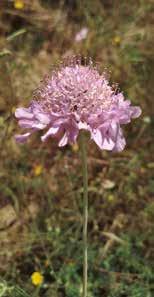
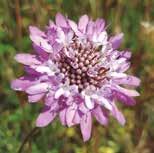
Planta espontânea em Portugal, cultivada em jardins, embora não seja muito comum nos jardins portugueses.
A sua identificação foi feita a partir do significado, conhecido na iconografia cemiterial.
This plant is native to Portugal and cultivated in gardens. It was identified thanks to its well-known symbolic meaning in cemetery iconography.

A saudade é das poucas flores cujo significado está no próprio nome: saudade. Também representa o luto.
Muito comum nos cemitérios portugueses no século XIX e início do século XX, muitas vezes conjugada com a Perpétua (outra flor cuja leitura simbólica passa pelo seu nome comum), para uma leitura conjunta: “Saudade Perpétua” ou “Perpétua Saudade”.
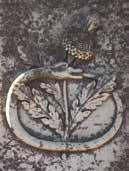
Em contrapartida, é muito rara a sua representação em contexto cemiterial fora de Portugal. Nessas situações excepcionais aparece em monumentos fúnebres de portugueses e seus descendentes ou em países com grande influência portuguesa durante o século XIX, como é o caso do Brasil.
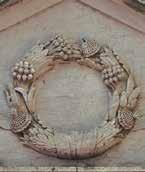
A saudade representa também o luto, pois sendo o roxo a sua cor mais comum (em várias tonalidades) e sendo essa uma das cores utilizadas pelas viúvas no século XIX na cultura ocidental para o
chamado luto aliviado (após o período de luto pleno, em que apenas era usado o preto, passavam ao período de luto aliviado em que era possível a utilização de outras cores, como o roxo, o cinzento, o castanho, etc.). Na língua inglesa esta flor é conhecida como mourningbride ou mournful-widow (ou seja “noiva enlutada” ou “viúva pesarosa”) devido à cor e à forma, que lembra as saias de luto utilizadas pelas senhoras de classe alta na época.
Apesar de actualmente esta planta ser quase desconhecida na sociedade portuguesa, o mesmo não acontecia no século XIX e inícios do século XX. Esta planta, com um nome tão português, era usada em diversos motivos e decorações, desde frontispícios de livros a azulejos e por isso facilmente reconhecida. Como exemplo da sua popularidade, o arquitecto português Raul Lino (1879-1974) desenhou em 1924 um serviço de loiça decorado com saudades, o qual chamou de “Saudade” e que foi produzido pela famosa fábrica da Viúva Lamego, em faiança e porcelana.

The mourningbride1 is one of the few flowers whose meaning is in its name: longing2. It also represents mourning. Very common in Portuguese cemeteries during the 19th and early 20th centuries, often combined with the everlasting flowers3 (another flower whose symbolic meaning is in its common name), for a joint reading: “Longing Everlasting” or “Everlasting Longing”.
Its representation in a cemeterial context outside Portugal is very rare. In those exceptional situations, it appears in funeral monuments of the Portuguese and their descendants, or in countries with great Portuguese influence during the 19th century, as is the case in Brazil.
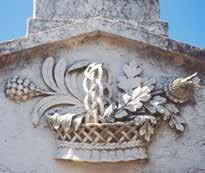
The mourningbride represents mourning, since purple is its most common colour (in various shades) and was also one of the colours used by widows in the 19th century
1 – Also known as sweet scabious.
in Western culture for the so-called relieved mourning (after the period of full mourning, in which only black was worn, they moved on to a period of relieved mourning, in which it was possible to wear other colours, such as purple, grey, brown, etc.). In English, this flower is known as mourningbride or mournful-widow due to its colour and shape, reminiscent of the mourning skirts worn by upper-class ladies at the time.
Although today this plant is almost unknown in Portuguese society, this was untrue in the 19th and early 20th centuries. This plant, with such a Portuguese name4, was used in several motifs and decorations, from book front pieces to azulejos (Portuguese tiles) and therefore easily recognisable. As an example of its popularity, in 1924 Portuguese architect Raul Lino (1879-1974) designed a dining set decorated with mourningbrides, which he called “Saudade” and which was produced, in faience and porcelain, by the famous Viúva Lamego’s factory.


2 – In Portuguese, the common name of the flower is saudade, a Portuguese word that can be translated as longing.
3 – Also known as curry plant.
4 – The Portuguese word Saudade refers to a very Portuguese feeling and has the reputation of being impossible to translate into other languages. It is very similar to longing, but mixed with melancholia and a deep sadness for things of the past, lost loves, impossible and unfulfilled dreams. It’s very connected to Fado, the national song.
EDIÇÃO | EDITION
Câmara Municipal de Lisboa
DIreção Municipal de Ambiente Estrutura Verde, Clima e Energia
Divisão de Gestão Cemiterial
COMISSARIADO | CURATORSHIP
Gisela Monteiro
Sandra Mesquita
Sara Gonçalves
PREFÁCIO E TEXTOS DE ABERTURA | FOREWORD AND OPENING TEXTS
José Sá Fernandes
Sara Gonçalves
Gisela Monteiro
Sandra Mesquita
TEXTOS | TEXTS
Botânica - Sandra Mesquita
Simbologia - Gisela Monteiro
DESIGN GRÁFICO | GRAPHIC DESIGN
José Dias - Design
TRADUÇÃO | TRANSLATION
Dos autores
By the authors
João Basto (Prefácio | Preface)
REVISÃO DA TRADUÇÃO | TRANSLATION REVIEW
Thao Thi Kahn
CRÉDITOS FOTOGRÁFICOS | PHOTOGRAPHIC CREDITS
Sandra Mesquita
Sara Gonçalves
Gisela Monteiro (Pag.153 - Cirsium vulgare)
Frédéric Bioret (Pag.165 - Convallaria majalis)
Venília Caeiro (Pag.177 - Sprekelia formosíssima)
Ashley Basil, https://www.flickr.com (Pag.65/2ªfoto - Phoenix dactylifera)
阿橋 HQ, https://www.flickr.com (Pag.69/1ªfoto - Salix alba)
B+ Fouzy, https://www.flickr.com (Pag.69/2ªfoto - Salix alba)
Abdulla Al Muhairi, https://www.flickr.com (Pag.65/1ªfoto - Phoenix dactylifera)
Apoxyomenus, https://commons.wikimedia.org/wiki/File:Purple_ Flower_%22Pensamiento%22_Viola_%C3%97_wittrockiana.JPG (Pag.81/1ªfoto - Viola×wittrockiana)
B.traeger, https://commons.wikimedia.org/wiki/File:Jasminum_officinale. JPG (Pag.105/1ªfoto - Jasminum_officinale)
Jim Evans, https://commons.wikimedia.org/wiki/File:Common_Jasmine.jpg (Pag.105/2ªfoto - Jasminum_officinale)
阿橋 HQ, https://www.flickr.com/photos/nhq9801/9240223484/in/ photolist-f5wyw1-bEkzm4-jdY7eR-jgXbvj-jtQLFA-jdY76p-fheU6zjmKQqn-bDK33X-je1q6C-92r2ka-8CTpTu-f6BhLg-jpXW9L-jmKPKpjmKS8a-je3rSm-jih53r-jrcUPN-jtNJfZ-jrcVB9-je3rHJ-XSUxTi-FQ7AhFYmA1UH-bZorwW-2avqDCP-YeXmDU-2dyZka9-2k8tcGS-2jZ4tEG2drjGCw-3eebQh-cxokbL-9WmBi-8aPr4h-5Vpdza-f3p12m-jdY6FrjgVjjR-f19nWB-jo7jCi-Zf1m9P-f39M4z-CPASPK-a4vMRr-YR8XPEccMrxf-ZFgCvS-h87xxw (Pag.109/1ªfoto - Chrysanthemum) Cillas, https://commons.wikimedia.org (Pag.125/1ªfoto - Zantedeschia aethiopica)
Seán A. O'Hara, https://www.flickr.com/photos/hortulus_aptus/33589463665/ in/photolist-TbbMiT-2hzGtZq-9ZsSpH-5fBonS-5fBkEU-7uhFBa-78MxhMdDmX2x-78RqHq-78Rrrm-nBcZnd-2hzLhH8-dUstH8-qvEdMF-2jstT1Cbr6385-7UAeog-918Wpv-7UAejn-6cBa35-7pAHH-dGNaWp-MaHCxMVmfSf1-7UAehV-buDjRU-5WVa9q-78MyBB-86e1iG-5WQWdH-2r71om5WV9aU-5WVakC-uEDpEn-5WQUAF-Xt7P4D-89fyHK-89fzUe-dDmWZarQuFnu-UGot2a-rSb96g-5CmuwK-mNvLu-buzzx5-rSmsXp-bHy6hM8GfGNN-buDjSN-64Zy4X (Pag.125/2ªfoto - Zantedeschia aethiopica) Petar Miloševic, https://commons.wikimedia.org/wiki/File:Sunflower_fields_ in_%C5%A0umadija.jpg (Pag.137/2ªfoto - Helianthus annuus)
F. D. Richards, https://www.flickr.com/photos/50697352@N00/48653610363/ in/photolist-2h8mti6-iZNLR6-o2aS43-2h8p4K2-fMybPD-iq4UuN-iVyUhS6Utcyk-6UteA8-7uT3HZ-iTYuqY-dVsLoh-2byuLvA-2i9bLem-iq4QJU-dFBL8yCKXYSE-iq4Qq6-8dbZzG-dFwkGX-NNXZKQ-GNuebX-226ARBY-226ASM3q4BaR1-dTBELu-ZMTXYv-KSa38T-2hBtJkH-iY8Vix-Aax7hP-nwDWxRh98nU6-PV59SP-2hrF3XG-G7aVGy-226AT5C-2iqTWXN-ZMTXDc-iXXYxs21E7Lmh-dDUUV8-pPWS77-FVnntZ-dDUV3c-actrzv-iXW1hz-QAr6ebiq4NPw-iq4Dgb (Pag.145/2ªfoto - Convolvulus tricolor)
F. D. Richards, https://www.flickr.com (Pag.149/1ªfoto - Paeonia officinalis)
Soartes
ISBN 978-989-96864-8-9
DEPÓSITO LEGAL | LEGAL DEPOSIT
477390/20
2.ª Edição – Lisboa 2022 | Lisbon 2022
500 exemplares | 500 copies
ORGANIZAÇÃO | ORGANIZATION
Câmara Municipal de Lisboa
DIreção Municipal de Ambiente Estrutura Verde, Clima e Energia
Divisão de Gestão Cemiterial
COMISSARIADO | CURATORSHIP
Gisela Monteiro
Sandra Mesquita
Sara Gonçalves
TEXTOS | TEXTS
Botânica - Sandra Mesquita
Simbologia - Gisela Monteiro
PROJETO MUSEOGRÁFICO | MUSEOGRAPHIC PROJECT
José Dias - Design
DESIGN GRÁFICO | GRAPHIC DESIGN
José Dias - Design
CRÉDITOS FOTOGRÁFICOS | PHOTOGRAPHIC CREDITS
Sandra Mesquita
Sara Gonçalves
Gisela Monteiro (Cirsium vulgare)
Frédéric Bioret (Convallaria majalis)
Venília Caeiro (Sprekelia formosíssima)
Ashley Basil, https://www.flickr.com (Phoenix dactylifera)
阿橋 HQ, https://www.flickr.com (Salix alba)
B+ Fouzy, https://www.flickr.com (Salix alba)
Abdulla Al Muhairi, https://www.flickr.com (Phoenix dactylifera)
Apoxyomenus, https://commons.wikimedia.org (Viola×wittrockiana)
B.traeger, https://commons.wikimedia.org (Jasminum_officinale)
Jim Evans, https://commons.wikimedia.org (Jasminum_officinale)
阿橋 HQ, https://www.flickr.com (Chrysanthemum)
Cillas, https://commons.wikimedia.org (Zantedeschia aethiopica)
Seán A. O'Hara, https://www.flickr.com (Zantedeschia aethiopica)
Petar Miloševic, https://commons.wikimedia.org ( Helianthus annuus)
F. D. Richards, https://www.flickr.com (Convolvulus tricolor)
F. D. Richards, https://www.flickr.com (Paeonia officinalis)
PRODUÇÃO GRÁFICA | GRAPHIC PRODUCTION
PortoDesign
TRADUÇÃO | TRANSLATION
Dos autores
By the authors
REVISÃO DA TRADUÇÃO | TRANSLATION REVIEW
Thao Thi Kahn
APOIO | SUPPORT
empréstimo de vitrines
showcase loan
